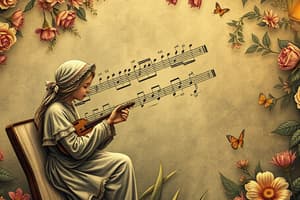Podcast
Questions and Answers
What is the mood of the Classical Period?
What is the mood of the Classical Period?
- Emotionally static compositions.
- Fluctuations of mood within one movement that were gradual/sudden. (correct)
- Complex rhythms without contrast.
- A single, consistent mood throughout a piece.
What are the three attributes of the Classical Symphony?
What are the three attributes of the Classical Symphony?
Made up of four distinct movements, wider range of tone color and dynamics, lasted between twenty and forty-five minutes.
What are the four parts of the Classical Sonata Form?
What are the four parts of the Classical Sonata Form?
Exposition, Development, Recapitulation, and Coda.
Who is considered to be the creator of the Classical Symphony?
Who is considered to be the creator of the Classical Symphony?
What is considered to be the most important form in Classical Chamber Music?
What is considered to be the most important form in Classical Chamber Music?
What are three major contributions of Joseph Haydn to Classical Music?
What are three major contributions of Joseph Haydn to Classical Music?
What four Classical Musical Forms did Mozart create masterpieces in?
What four Classical Musical Forms did Mozart create masterpieces in?
What is Individuality of Style in classical music?
What is Individuality of Style in classical music?
What does expressiveness from the Romantic Period entail?
What does expressiveness from the Romantic Period entail?
What is the tone color of the Romantic Period?
What is the tone color of the Romantic Period?
What is the dynamics, pitch, and tempo like in the Romantic Period?
What is the dynamics, pitch, and tempo like in the Romantic Period?
What is nationalism in the Romantic Period?
What is nationalism in the Romantic Period?
What is exoticism in the Romantic Period?
What is exoticism in the Romantic Period?
What is program music of the Romantic Period?
What is program music of the Romantic Period?
What is the Art Song of the Romantic Period?
What is the Art Song of the Romantic Period?
Who was a prominent composer of the Art Song?
Who was a prominent composer of the Art Song?
What Classical composer is considered to have created a bridge between the Classical and Romantic Periods of music?
What Classical composer is considered to have created a bridge between the Classical and Romantic Periods of music?
What major Classical form did Beethoven use to create this 'bridge'?
What major Classical form did Beethoven use to create this 'bridge'?
Flashcards are hidden until you start studying
Study Notes
Mood of the Classical Period
- Characterized by fluctuations, creating gradual or sudden contrasts within a single movement.
Rhythm of the Classical Period
- Featured flexible rhythms with unexpected pauses, syncopations, and switched between long and short notes to enhance variety.
Texture of the Classical Period
- Primarily homophonic but versatile; pieces could shift smoothly or suddenly between textures.
Melody of the Classical Period
- Melodies were generally tuneful, easy to remember, often reflecting pop or folk influences, structured from two equally long phrases.
Dynamics of the Classical Period
- Emphasized gradual dynamic shifts, utilizing crescendos and decrescendos extensively.
Fortepiano
- An early version of the piano that replaced the harpsichord, noted for its small pitch range compared to modern pianos.
Classical Sonata Form
- Comprises four parts: Exposition, Development, Recapitulation, and Coda.
Exposition
- Introduces the first theme in the tonic (home) key.
Development
- The theme undergoes new treatments and variations.
Recapitulation
- Reintroduces the first and second themes, both in the tonic key.
Coda
- Concludes the piece by repeating themes.
Classical Symphony Attributes
- Consists of four distinct movements: fast, lyrical, dancelike, and fast again; has a wider dynamic range and tone color compared to earlier orchestras; typical duration is between twenty and forty-five minutes.
Creator of the Classical Symphony
- Joseph Haydn is recognized as the originator of the Classical symphony.
Classical Concerto
- A three-movement composition featuring an instrumental soloist with an orchestra.
Classical Chamber Music
- The string quartet is the most significant form in this genre.
Joseph Haydn's Contributions
- Pioneered the symphony and string quartet formats; influenced significant composers such as Mozart and Beethoven.
Mozart's Role in the Classical Period
- Renowned as the greatest melody writer and opera composer of his time.
Mozart's Masterpieces
- Created significant works in symphonies, string quartets, piano concertos, and operas.
Individuality of Style
- Composers emphasized unique musical styles that reflected their personal characteristics.
Expressiveness from the Romantic Period
- Explored a vast range of emotions, including flamboyance, intimacy, unpredictability, melancholy, rapture, and longing.
Tone Color of the Romantic Period
- Focused on rich and sensuous sounds, achieving diverse moods using larger orchestral size compared to the Classical period.
Texture and Harmony of the Romantic Period
- Composers sought emotional intensity by developing new and complex chords, emphasizing colorful harmonies.
Dynamics, Pitch, and Tempo of the Romantic Period
- Marked a wider range of dynamics, pitch, and tempo compared to previous eras.
Nationalism in the Romantic Period
- Composers embraced elements of specific national identities, integrating folk songs, dances, and historical themes into their works.
Exoticism in the Romantic Period
- Involved the use of materials inspired by foreign cultures, such as Asian musical styles.
Program Music of the Romantic Period
- Instrumental compositions that relate to a narrative, poem, idea, or scene.
Art Song of the Romantic Period
- A composition for solo voice accompanied by piano, merging poetry and music intimately.
Prominent Composer of the Art Song
- Franz Schubert is celebrated for his contributions to this genre.
Bridge between Classical and Romantic Periods
- Beethoven is recognized for connecting the two eras through his innovative techniques.
Major Classical Form Used by Beethoven
- His nine symphonies showcased classical methodologies while infusing greater intensity and power.
Studying That Suits You
Use AI to generate personalized quizzes and flashcards to suit your learning preferences.




